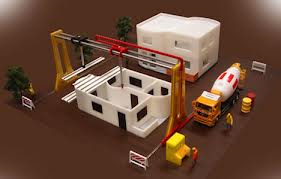 Around for a few years now, 3D printing allows a computer aided design (CAD) models to be created using Additive Manufacturing. It has moved into many disciplines including product design, fashion and even biological tissue building. It didn’t take too long for the concept to be taken on by the construction and building industry for concrete elements and now large scale housing construction is taking place by a Chinese company based in Suzhou.
Around for a few years now, 3D printing allows a computer aided design (CAD) models to be created using Additive Manufacturing. It has moved into many disciplines including product design, fashion and even biological tissue building. It didn’t take too long for the concept to be taken on by the construction and building industry for concrete elements and now large scale housing construction is taking place by a Chinese company based in Suzhou.
The Method
Objects are created via a scan or digital file sent to a printer with the item being built layer by layer and the company has now used this method to construct ten houses in less than 24 hours. The cost has come in at around $5000 using just four 10m x 6.6m x 32m printers to spray a mix of cement and construction waste. The process involves the creation of building blocks with a diagonally reinforced print pattern which leaves plenty of air space to act as insulation. Once printed the blocks can be transported and quickly assembled on site.
The company estimates a saving of up to 60% in materials and 80% in labour compared to traditional methods and reduces many of the hazards found on traditional construction sites. As well as all this, the build would be around 70% faster. They also anticipate being able to build skyscrapers in future. The printers can build to a wide range of digital designs according to customer requirements.
In Europe too…
The Dutch, not to be outdone are also in the process of creating a house using plastics based heavily on plant oil. This concept has been initiated by DUS architects, an Amsterdam based architecture office founded in 2004 by Hans Vermeulen, Hedwig Heinsman and Martine de Wit.
They currently house the printer in a shipping container with the idea that it can be moved to whatever location needed. Again, pieces for the house are individually created to be slotted together. It could be that plastic waste could eventually be used for this process. Actually in Amsterdam, the 3D Print Canal House is an exhibition, research and building site for 3D Printing Architecture. Their ambition – to cut transport cost, create unique facades to suit customer needs and reduce waste as the process goes straight from raw material to end product. They also feel that other products could be used and are looking at wooden pallets and natural stone waste, all in keeping with sustainable practices.
The Dutch project is designed to take up to 3 years – it’s a research and design project rather than a quick fix to a housing shortage and they point out that in the future 3D houses will be built on a much quicker scale.
